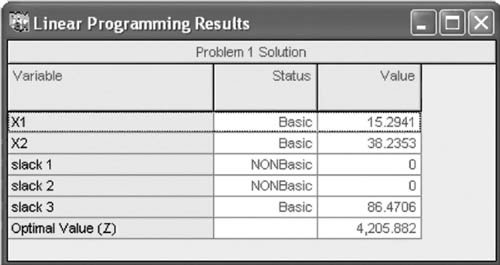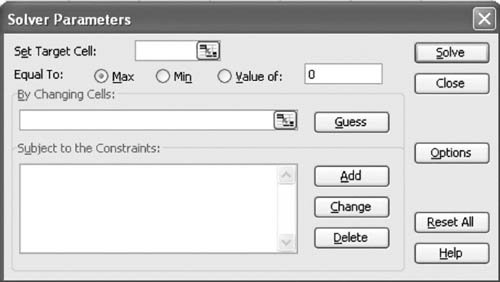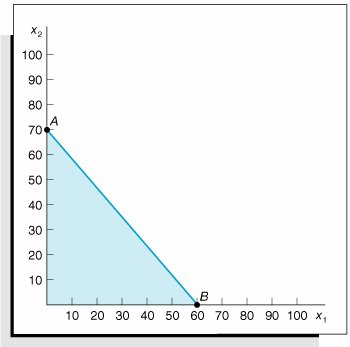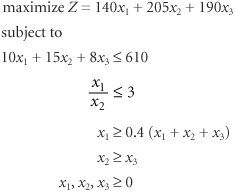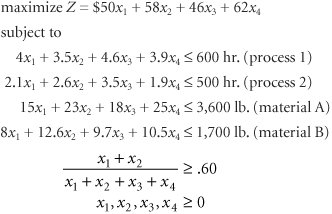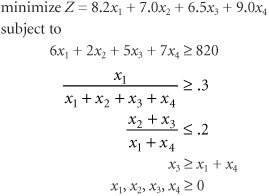Problems
| 1. | Given the following QM for Windows computer solution of a linear programming model, graph the problem and identify the solution point, including variable values and slack , from the computer output:  | ||||||||||||||||||||||||||||||
| 2. | Explain the primary differences between a software package such as QM for Windows and Excel spreadsheets for solving linear programming problems. | ||||||||||||||||||||||||||||||
| 3. | Given the following Excel spreadsheet for a linear programming model and Solver window, indicate the formula for cell B13 and fill in the Solver window with the appropriate information to solve the problem: 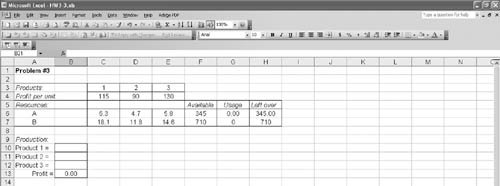 | ||||||||||||||||||||||||||||||
| 4. | Given the following graph of a linear programming model with a single constraint and the objective function maximize Z = 30 x 1 + 50 x 2 , determine the optimal solution point: Determine the values by which c 1 and c 2 must decrease or increase in order to change the current solution point to the other extreme point. | ||||||||||||||||||||||||||||||
| 5. | Southern Sporting Goods Company makes basketballs and footballs. Each product is produced from two resourcesrubber and leather. The resource requirements for each product and the total resources available are as follows :
Each basketball produced results in a profit of $12, and each football earns $16 in profit.
| ||||||||||||||||||||||||||||||
| 6. | Solve the model formulated in Problem 5 for Southern Sporting Goods Company graphically.
| ||||||||||||||||||||||||||||||
| 7. | For the linear programming model for Southern Sporting Goods Company, formulated in Problem 5 and solved graphically in Problem 6:
| ||||||||||||||||||||||||||||||
| 8. | A company produces two products, A and B, which have profits of $9 and $7, respectively. Each unit of product must be processed on two assembly lines, where the required production times are as follows.
| ||||||||||||||||||||||||||||||
| 9. | Solve Problem 8 graphically.
| ||||||||||||||||||||||||||||||
| 10. | For the linear programming model formulated in Problem 8 and solved graphically in Problem 9:
| ||||||||||||||||||||||||||||||
| | |||||||||||||||||||||||||||||||
| 11. | Irwin Textile Mills produces two types of cotton clothdenim and corduroy. Corduroy is a heavier grade of cotton cloth and, as such, requires 7.5 pounds of raw cotton per yard, whereas denim requires 5 pounds of raw cotton per yard. A yard of corduroy requires 3.2 hours of processing time; a yard of denim requires 3.0 hours. Although the demand for denim is practically unlimited, the maximum demand for corduroy is 510 yards per month. The manufacturer has 6,500 pounds of cotton and 3,000 hours of processing time available each month. The manufacturer makes a profit of $2.25 per yard of denim and $3.10 per yard of corduroy. The manufacturer wants to know how many yards of each type of cloth to produce to maximize profit.
| ||||||||||||||||||||||||||||||
| 12. | Solve the model formulated in Problem 11 for Irwin Textile Mills graphically.
| ||||||||||||||||||||||||||||||
| 13. | Solve the linear programming model formulated in Problem 11 for Irwin Mills by using the computer.
| ||||||||||||||||||||||||||||||
| 14. | United Aluminum Company of Cincinnati produces three grades (high, medium, and low) of aluminum at two mills. Each mill has a different production capacity (in tons per day) for each grade, as follows:
The company has contracted with a manufacturing firm to supply at least 12 tons of high-grade aluminum, 8 tons of medium-grade aluminum, and 5 tons of low-grade aluminum. It costs United $6,000 per day to operate mill 1 and $7,000 per day to operate mill 2. The company wants to know the number of days to operate each mill in order to meet the contract at the minimum cost. Formulate a linear programming model for this problem. | ||||||||||||||||||||||||||||||
| 15. | Solve the linear programming model formulated in Problem 14 for United Aluminum Company graphically.
| ||||||||||||||||||||||||||||||
| 16. | Solve the linear programming model formulated in Problem 14 for United Aluminum Company by using the computer.
| ||||||||||||||||||||||||||||||
| 17. | The Bradley family owns 410 acres of farmland in North Carolina on which they grow corn and tobacco. Each acre of corn costs $105 to plant, cultivate, and harvest; each acre of tobacco costs $210. The Bradleys have a budget of $52,500 for next year. The government limits the number of acres of tobacco that can be planted to 100. The profit from each acre of corn is $300; the profit from each acre of tobacco is $520. The Bradleys want to know how many acres of each crop to plant in order to maximize their profit. Formulate a linear programming model for this problem. | ||||||||||||||||||||||||||||||
| 18. | Solve the linear programming model formulated in Problem 17 for the Bradley family farm graphically.
| ||||||||||||||||||||||||||||||
| 19. | Solve the linear programming model formulated in Problem 17 for the Bradley farm by using the computer.
| ||||||||||||||||||||||||||||||
| 20. | The manager of a Burger Doodle franchise wants to determine how many sausage biscuits and ham biscuits to prepare each morning for breakfast customers. The two types of biscuits require the following resources:
The franchise has 6 hours of labor available each morning. The manager has a contract with a local grocer for 30 pounds of sausage and 30 pounds of ham each morning. The manager also purchases 16 pounds of flour. The profit for a sausage biscuit is $0.60; the profit for a ham biscuit is $0.50. The manager wants to know the number of each type of biscuit to prepare each morning in order to maximize profit. Formulate a linear programming model for this problem. | ||||||||||||||||||||||||||||||
| 21. | Solve the linear programming model formulated in Problem 20 for the Burger Doodle restaurant graphically.
| ||||||||||||||||||||||||||||||
| 22. | Solve the linear programming model developed in Problem 20 for the Burger Doodle restaurant by using the computer.
| ||||||||||||||||||||||||||||||
| 23. | Rucklehouse Public Relations has been contracted to do a survey following an election primary in New Hampshire. The firm must assign interviewers to conduct the survey by telephone or in person. One person can conduct 80 telephone interviews or 40 personal interviews in a single day. The following criteria have been established by the firm to ensure a representative survey:
An interviewer conducts only one type of interview each day. The cost is $50 per day for a telephone interviewer and $70 per day for a personal interviewer. The firm wants to know the minimum number of interviewers to hire in order to minimize the total cost of the survey. Formulate a linear programming model for this problem. | ||||||||||||||||||||||||||||||
| 24. | Solve the linear programming model formulated in Problem 23 for Rucklehouse Public Relations graphically.
| ||||||||||||||||||||||||||||||
| 25. | Solve the linear programming model formulated in Problem 23 for Rucklehouse Public Relations by using the computer.
| ||||||||||||||||||||||||||||||
| 26. | The Bluegrass Distillery produces custom-blended whiskey. A particular blend consists of rye and bourbon whiskey. The company has received an order for a minimum of 400 gallons of the custom blend. The customer specified that the order must contain at least 40% rye and not more than 250 gallons of bourbon. The customer also specified that the blend should be mixed in the ratio of two parts rye to one part bourbon. The distillery can produce 500 gallons per week, regardless of the blend. The production manager wants to complete the order in 1 week. The blend is sold for $5 per gallon. The distillery company's cost per gallon is $2 for rye and $1 for bourbon. The company wants to determine the blend mix that will meet customer requirements and maximize profits. Formulate a linear programming model for this problem. | ||||||||||||||||||||||||||||||
| 27. | Solve the linear programming model formulated in Problem 26 for the Bluegrass Distillery graphically.
| ||||||||||||||||||||||||||||||
| 28. | Solve the linear programming model formulated in Problem 26 for the Bluegrass Distillery by using the computer.
| ||||||||||||||||||||||||||||||
| 29. | Alexis Harrington received an inheritance of $95,000, and she is considering two speculative investmentsthe purchase of land and the purchase of cattle. Each investment would be for 1 year. Under the present (normal) economic conditions, each dollar invested in land will return the principal plus 20% of the principal; each dollar invested in cattle will return the principal plus 30%. However, both investments are relatively risky. If economic conditions were to deteriorate, there is an 18% chance she would lose everything she invested in land and a 30% chance she would lose everything she invested in cattle. Alexis does not want to lose more than $20,000 (on average). She wants to know how much to invest in each alternative to maximize the cash value of the investments at the end of 1 year. Formulate a linear programming model for this problem. | ||||||||||||||||||||||||||||||
| 30. | Solve the linear programming model formulated in Problem 29 for Alexis Harrington graphically.
| ||||||||||||||||||||||||||||||
| 31. | Solve the linear programming model formulated in Problem 29 for Alexis Harrington by using the computer.
| ||||||||||||||||||||||||||||||
| | |||||||||||||||||||||||||||||||
| 32. | Transform the following linear programming model into standard form and solve by using the computer: | ||||||||||||||||||||||||||||||
| 33. | Chemco Corporation produces a chemical mixture for a specific customer in 1,000- pound batches. The mixture contains three ingredientszinc, mercury , and potassium. The mixture must conform to formula specifications that are supplied by the customer. The company wants to know the amount of each ingredient it needs to put in the mixture that will meet all the requirements of the mix and minimize total cost. The customer has supplied the following formula specifications for each batch of mixture:
The cost per pound of mercury is $400; the cost per pound of zinc, $180; and the cost per pound of potassium, $90.
| ||||||||||||||||||||||||||||||
| 34. | The following linear programming model formulation is used for the production of four different products, with two different manufacturing processes and two different material requirements:
| ||||||||||||||||||||||||||||||
| 35. | Island Publishing Company publishes two types of magazines on a monthly basis: a restaurant and entertainment guide and a real estate guide. The company distributes the magazines free to businesses, hotels, and stores on Hilton Head Island in South Carolina. The company's profits come exclusively from the paid advertising in the magazines. Each of the restaurant and entertainment guides distributed generates $0.50 per magazine in advertising revenue, whereas the real estate guide generates $0.75 per magazine. The real estate magazine is a more sophisticated publication that includes color photos, and accordingly it costs $0.25 per magazine to print, compared with only $0.17 for the restaurant and entertainment guide. The publishing company has a printing budget of $4,000 per month. There is enough rack space to distribute at most 18,000 magazines each month. In order to entice businesses to place advertisements, Island Publishing promises to distribute at least 8,000 copies of each magazine. The company wants to determine the number of copies of each magazine it should print each month in order to maximize advertising revenue. Formulate a linear programming model for this problem. | ||||||||||||||||||||||||||||||
| 36. | Solve the linear programming model formulation in Problem 35 for Island Publishing Company graphically.
| ||||||||||||||||||||||||||||||
| 37. | Solve the linear programming model formulated in Problem 35 for Island Publishing Company by using the computer.
| ||||||||||||||||||||||||||||||
| 38. | Mega-Mart, a discount store chain, is to build a new store in Rock Springs. The parcel of land the company has purchased is large enough to accommodate a store with 140,000 square feet of floor space. Based on marketing and demographic surveys of the area and historical data from its other stores, Mega-Mart estimates its annual profit per square foot for each of the store's departments to be as shown in the following table:
Each department must have at least 15,000 ft. 2 of floor space, and no department can have more than 20% of the total retail floor space. Men's, women's, and children's clothing plus housewares keep all their stock on the retail floor; however, toys, electronics, and auto supplies keep some items (such as bicycles, televisions , and tires) in inventory. Thus, 10% of the total retail floor space devoted to these three departments must be set aside outside the retail area for stocking inventory. Mega-Mart wants to know the floor space that should be devoted to each department in order to maximize profit.
| ||||||||||||||||||||||||||||||
| | |||||||||||||||||||||||||||||||
| 39. |
| ||||||||||||||||||||||||||||||
| 40. | The Food Max grocery store sells three brands of milk in half-gallon cartonsits own brand, a local dairy brand, and a national brand. The profit from its own brand is $0.97 per carton, the profit from the local dairy brand is $0.83 per carton, and the profit from the national brand is $0.69 per carton. The total refrigerated shelf space allotted to half-gallon cartons of milk is 36 square feet per week. A half-gallon carton takes up 16 square inches of shelf space. The store manager knows that each week Food Max always sells more of the national brand than of the local dairy brand and its own brand combined and at least three times as much of the national brand as its own brand. In addition, the local dairy can supply only 10 dozen cartons per week. The store manager wants to know how many half-gallon cartons of each brand to stock each week in order to maximize profit.
| ||||||||||||||||||||||||||||||
| 41. |
| ||||||||||||||||||||||||||||||
| 42. | John Hoke owns Hoke's Spokes, a bicycle shop. Most of John's bicycle sales are customer orders; however, he also stocks bicycles for walk-in customers. He stocks three types of bicyclesroad-racing, cross-country, and mountain. A road-racing bike costs $1,200, a cross-country bike costs $1,700, and a mountain bike costs $900. He sells road-racing bikes for $1,800, cross-country bikes for $2,100, and mountain bikes for $1,200. He has $12,000 available this month to purchase bikes. Each bike must be assembled ; a road-racing bike requires 8 hours to assemble, a cross-country bike requires 12 hours, and a mountain bike requires 16 hours. He estimates that he and his employees have 120 hours available to assemble bikes. He has enough space in his store to order 20 bikes this month. Based on past sales, John wants to stock at least twice as many mountain bikes as the other two combined because mountain bikes sell better. Formulate a linear programming model for this problem. | ||||||||||||||||||||||||||||||
| 43. | Solve the linear programming model formulated in Problem 42 for Hoke's Spokes by using the computer.
| ||||||||||||||||||||||||||||||
| 44. | Metro Food Services Company delivers fresh sandwiches each morning to vending machines throughout the city. The company makes three kinds of sandwichesham and cheese, bologna, and chicken salad. A ham and cheese sandwich requires a worker 0.45 minutes to assemble, a bologna sandwich requires 0.41 minutes, and a chicken salad sandwich requires 0.50 minutes to make. The company has 960 available minutes each night for sandwich assembly. Vending machine capacity is available for 2,000 sandwiches each day. The profit for a ham and cheese sandwich is $0.35, the profit for a bologna sandwich is $0.42, and the profit for a chicken salad sandwich is $0.37. The company knows from past sales records that its customers buy as many or more of the ham and cheese sandwiches than the other two sandwiches combined, but customers need a variety of sandwiches available, so Metro stocks at least 200 of each. Metro management wants to know how many of each sandwich it should stock to maximize profit. Formulate a linear programming model for this problem. | ||||||||||||||||||||||||||||||
| 45. | Solve the linear programming problem formulated in Problem 44 for Metro Food Services Company by using the computer.
| ||||||||||||||||||||||||||||||
| 46. | Mountain Laurel Vineyards produces three kinds of wineMountain Blanc, Mountain Red, and Mountain Blush. The company has 17 tons of grapes available to produce wine this season . A cask of Blanc requires 0.21 tons of grapes, a cask of Red requires 0.24 tons, and a cask of Blush requires 0.18 tons. The vineyard has enough storage space in its aging room to store 80 casks of wine. The vineyard has 2,500 hours of production capacity, and it requires 12 hours to produce a cask of Blanc, 14.5 hours to produce a cask of Red, and 16 hours to produce a cask of Blush. From past sales the vineyard knows that demand for the Blush will be no more than half of the sales of the other two wines combined. The profit for a cask of Blanc is $7,500, the profit for a cask of Red is $8,200, and the profit for a cask of Blush is $10,500. Formulate a linear programming model for this problem. | ||||||||||||||||||||||||||||||
| 47. | Solve the linear programming model formulated in Problem 46 for Mountain Laurel Vineyards by using the computer.
| ||||||||||||||||||||||||||||||
| 48. | Exeter Mines produces iron ore at four different mines; however, the ores extracted at each mine are different in their iron content. Mine 1 produces magnetite ore, which has a 70% iron content; mine 2 produces limonite ore, which has a 60% iron content; mine 3 produces pyrite ore, which has a 50% iron content; and mine 4 produces taconite ore, which has only a 30% iron content. Exeter has three customers that produce steelArmco, Best, and Corcom. Armco needs 400 tons of pure (100%) iron, Best requires 250 tons of pure iron, and Corcom requires 290 tons. It costs $37 to extract and process 1 ton of magnetite ore at mine 1, $46 to produce 1 ton of limonite ore at mine 2, $50 per ton of pyrite ore at mine 3, and $42 per ton of taconite ore at mine 4. Exeter can extract 350 tons of ore at mine 1; 530 tons at mine 2; 610 tons at mine 3; and 490 tons at mine 4. The company wants to know how much ore to produce at each mine in order to minimize cost and meet its customers' demand for pure (100%) iron. Formulate a linear programming model for this problem | ||||||||||||||||||||||||||||||
| 49. | Solve the linear programming problem formulated in Problem 48 for Exeter Mines by using the computer.
| ||||||||||||||||||||||||||||||
| 50. | Given the following linear programming model: transform the model into standard form and solve by using the computer. | ||||||||||||||||||||||||||||||
| 51. | Marie McCoy has committed to the local PTA to make some items for a bake sale on Saturday. She has decided to make some combination of chocolate cakes, loaves of white bread, custard pies, and sugar cookies. Thursday evening she went to the store and purchased 20 pounds of flour, 10 pounds of sugar, and 3 dozen eggs, which are the three main ingredients in all the baked goods she is thinking about making. The following table shows how much of each of the main ingredients is required for each baked good:
There are 18.5 cups in a 5 pound bag of flour and 12 cups in a 5 pound bag of sugar. Marie plans to get up and start baking on Friday morning after her kids leave for school and finish before they return after soccer practice (8 hours). She knows that the PTA will sell a chocolate cake for $12, a loaf of bread for $8, a custard pie for $10, and a batch of cookies for $6. Marie wants to decide how many of each type of baked good she should make in order for the PTA to make the most money possible. Formulate a linear programming model for this problem. | ||||||||||||||||||||||||||||||
| 52. | Solve the linear programming model formulated in Problem 51 for Marie McCoy.
| ||||||||||||||||||||||||||||||
EAN: 2147483647
Pages: 358
- Chapter III Two Models of Online Patronage: Why Do Consumers Shop on the Internet?
- Chapter IX Extrinsic Plus Intrinsic Human Factors Influencing the Web Usage
- Chapter XII Web Design and E-Commerce
- Chapter XVI Turning Web Surfers into Loyal Customers: Cognitive Lock-In Through Interface Design and Web Site Usability
- Chapter XVIII Web Systems Design, Litigation, and Online Consumer Behavior
